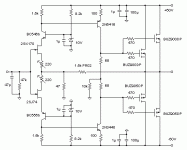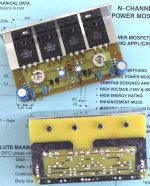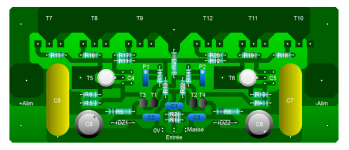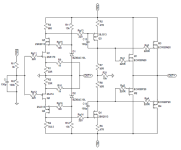I morphed my F5 boards to F5M and I am happy what I hear! Thank you Nelson!
The Holy Grail Follower Output Stage has much lower distortion, which becomes apparent vs. the F5m at higher output frequencies and power levels.
The comparison is not completely fair since my implementation of the F5m uses Fairchiild IRFP9140 PFETs which have known issues.
The comparison is not completely fair since my implementation of the F5m uses Fairchiild IRFP9140 PFETs which have known issues.
May I add, my F5 M shows no thump noise switching on or off, very nice.
Is the F5m an upgrade to ACAmini?I built an ACAmini for my dad last year and he loves it. I may give him the F5m as an upgrade.
Been away from the diy audioworld for 20 years and have just returned - to be blown off my feet by how incredible vast this world has become. Now l don’t know where to resume…
Can’t be around here long though, to notice that some Nelson Pass construction would be appropriate. But which one?
Kind regards.
If you are comfortable operating with mains voltages (I mean if you are sure about all safety measures) this looks like a great project to resume the hobby.
Otherwise, ACA mini, ACA or Zenductor are all good way to go. Maybe consider your speakers before choosing. And have fun!
Otherwise, ACA mini, ACA or Zenductor are all good way to go. Maybe consider your speakers before choosing. And have fun!
Last edited:
Maybe It has been asked, but can this circuit be upscaled like the F5Turbo with a very high powersupply voltage? And how is thermal stability ensured on this circuit, will higher powersupply voltage influence that?
Is the F5m an upgrade to ACAmini?
Been away from the diy audioworld for 20 years and have just returned - to be blown off my feet by how incredible vast this world has become. Now l don’t know where to resume…
Generally speaking, any of the Firstwatt amplifiers are going to be a notable and significant upgrade to any of the ACA amplifiers. For a myriad of reasons, including voltage swing, current delivery, and clipping behavior.
I like ACAmini a lot, it’s a fantastic sounding amplifier and has a quality that belies its small size and meager price, it sounds amazing in most situations and with the right speakers it could be my “desert island” amplifier. But the overall upscaling of everything in the larger amps, including F5m, is broadly beneficial. So is it an upgrade? In my opinion, clearly yes.
Maybe It has been asked, but can this circuit be upscaled like the F5Turbo with a very high powersupply voltage? And how is thermal stability ensured on this circuit, will higher powersupply voltage influence that?
Yes and no… the limit being a combination of voltage limits of the Jfet input pair, output device dissipation, and stability, the higher-power F5 seem to need the compensation cap to make sure they don’t do anything silly in the 100-200K range…
If you want higher supply voltage and power in an F5, I’d suggest building an F5T, or just waiting for the new, higher-power version that will be released in the not-too-distant-future, because F5m is just the first of a handful of F5 variations that will be available from Nelson.
😎
waiting for the new, higher-power version that will be released in the not-too-distant-future
… unless you routinely listen at “crank off the neighbors” loud, or have particularly inefficient speakers, yes, 25w IS a lot.
The Holy Grail Follower Output Stage has much lower distortion,
which becomes apparent vs. the F5m at higher output frequencies and power levels.
In addition, the open loop gain of the second stage of the F5 / F5T / F5m (and their 2-stage variants) are speaker load dependent.
This can be overcome by using an additional unity-gain source-follower output stage to delivery current to the speaker.
As can be seen in e.g "Burning Amp" power amps or many others.
Patrick
Thanks for the info 6L6. I will wait and see the upcoming variants of F5´s. I am sure the input fets needs cascoding, but It would be nice with a more simpel bias solution. I have a power supply of +/-58V but It might not be use full for these amps.
Attachments
And the version we actually built.
We call it F5EXC.
Another similar version you can find here :
https://www.diyaudio.com/community/threads/f5-meets-buzquito.162042/post-2097690
Patrick
We call it F5EXC.
Another similar version you can find here :
https://www.diyaudio.com/community/threads/f5-meets-buzquito.162042/post-2097690
Patrick
Attachments
Thanks EUVL, this could be an option. The 220ohm potentiometers are they adjusting offset or bias, or both?
Could this be the basic diagram for a Pass XA25 only something to control thermal runaway is needed for the big switch mosfets.
Could this be the basic diagram for a Pass XA25 only something to control thermal runaway is needed for the big switch mosfets.
Why bother with an additional follower output stage ?
You can read page 6 of this article :
https://www.passdiy.com/pdf/diyopamp.pdf
"The follower not only gives a lower output impedance, but makes the performance of the amplifier less dependent on the load impedance.
If you want to drive a lower impedance load, particularly a loudspeaker, you will want some current gain, and very often you will want this third stage."
Patrick
You can read page 6 of this article :
https://www.passdiy.com/pdf/diyopamp.pdf
"The follower not only gives a lower output impedance, but makes the performance of the amplifier less dependent on the load impedance.
If you want to drive a lower impedance load, particularly a loudspeaker, you will want some current gain, and very often you will want this third stage."
Patrick
- Home
- Amplifiers
- Pass Labs
- Pass F5m



